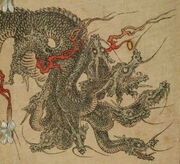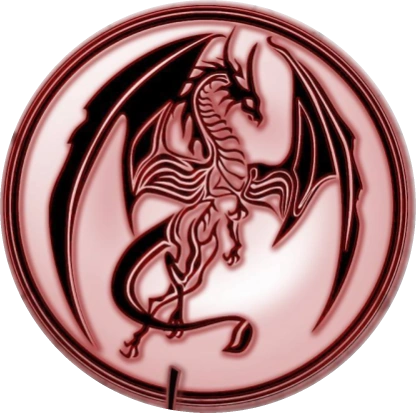
Yamata no Orochi (八岐大蛇 (ヤマタノオロチ), "eight-branched giant snake") or Orochi (大蛇), is a legendary eight-headed and eight-tailed dragon in ancient Japanese and Shinto mythology.
Mythology[]
The Yamata no Orochi legends are originally recorded in two ancient texts about Japanese mythology and history. The ca. 680 AD test of the Kojiki transcribes this dragon name as 八岐遠呂智. The ca. 720 AD text of the Nihongi writes it as 八岐大蛇. In both versions of the Orochi myth, the Shinto storm god Susanoo or Susa-no-Ō is expelled from Heaven for tricking his sister Amaterasu the sun-goddess.
After expulsion from Heaven, Susanoo encounters two "Earthly Deities" (國神, kunitsukami) near the head of the Hi River (簸川), now called the Hii River (斐伊川), in Izumo Province. They are weeping because they were forced to give the Orochi one of their daughters every year for seven years, and now they must sacrifice their eighth, Kushi-inada-hime (櫛名田比売 "comb/wondrous rice-field princess", who Susanoo transforms into a kushi 櫛 "comb" for safekeeping). The Kojiki tells the following version:
- "So, having been expelled, [His-Swift-impetuous-Male-Augustness] descended to a place [called] Tori-kami (鳥髪, now 鳥上) at the head-waters of the River Hi in the Land of Idzumo. At this time some chopsticks came floating down the stream. So His-Swift-Impetuous-Male-Augustness, thinking that there must be people at the head-waters of the river, went up it in quest of them, when he came upon an old man and an old woman, --two of them,--who had a young girl between them, and were weeping. Then he deigned to ask: "Who are ye?" So the old man replied, saying: "I am an Earthly Deity, child of the Deity Great-Mountain-Possessor. I am called by the name of Foot-Stroking-Elder, my wife is called by the name of Hand-Stroking Elder, and my daughter is called by the name of Wondrous-Inada-Princess." Again he asked: What is the cause of your crying?" [The old man answered] saying: "I had originally eight young girls as daughters. But the eight-forked serpent of Koshi has come every year and devoured [one], and it is now its time to come, wherefore we weep." Then he asked him: "What is its form like?" [The old man] answered, saying: "Its eyes are like akakagachi, it has one body with eight heads and eight tails. Moreover on its body grows moss, and also chamaecyparis and cryptomerias. Its length extends over eight valleys and eight hills, and if one look at its belly, it is all constantly bloody and inflamed." (What is called here akakagachi is the modern hohodzuki [winter-cherry]) Then His-Swift-Impetuous-Male-Augustness said to the old man: "If this be thy daughter, wilt thou offer her to me?" He replied, saying: "With reverence, but I know not thine august name." Then he replied, saying: "I am elder brother to the Heaven-Shining-Great-August-Deity. So I have now descended from Heaven." Then the Deities Foot-Stroker-Elder and Hand-Stroking-Elder said: "If that be so, with reverence will we offer [her to thee]." So His-Swift-Impetuous-Male-Augustness, at once taking and changing the young girl into a multitudinous and close-toothed comb which he stuck into his august hair-bunch, said to the Deities Foot-Stroking-Elder and Hand-Stroking-Elder: "Do you distill some eight-fold refined liquor. Also make a fence round about, in that fence make eight gates, at each gate tie [together] eight platforms, on each platform put a liquor-vat, and into each vat pour the eight-fold refined liquor, and wait." So as they waited after having thus prepared everything in accordance with his bidding, the eight-forked serpent came truly as [the old man] had said, and immediately dipped a head into each vat, and drank the liquor. Thereupon it was intoxicated with drinking, and all [the heads] lay down and slept. Then His-Swift-Impetuous-Male-Augustness drew the ten-grasp sabre, that was augustly girded on him, and cut the serpent in pieces, so that the River Hi flowed on changed into a river of blood. So when he cut the middle tail, the edge of his august sword broke. Then, thinking it strange, he thrust into and split [the flesh] with the point of his august sword and looked, and there was a great sword [within]. So he took this great sword, and, thinking it a strange thing, he respectfully informed the Heaven-Shining-Great-August-Deity. This is the Herb-Quelling Great Sword."
- ―Kojiki 71-3 (tr. Chamberlain 1919)
Compare the Nihongi description of Yamata no Orochi.
- "It had an eight-forked head and an eight-forked tail; its eyes were red, like the winter-cherry; and on its back firs and cypresses were growing. As it crawled it extended over a space of eight hills and eight valleys."
- ―Nihongi 1:52-53 (tr. Aston 1896)
These botanical names used to describe this Orochi are akakagachi or hoozuki ("winter cherry or Japanese lantern, Physalis alkekengi"), hikage ("club moss, Lycopodiopsida), hinoki ("Japanese cypress, Chamaecyparis obtusa), and sugi ("Japanese cedar, Cryptomeria").
The legendary sword Kusanagi-no-Tsurugi, which came from the tail of Yamata no Orochi, along with the Yata-no-Kagami mirror and Yasakani-no-Magatama jewel or orb, later became the three sacred Imperial Regalia of Japan used in the ritual of imperial ascension.
Analysis[]
The origins of Yamato no Orochi remain ambiguous. The dragon is often thought to represent a river god or even a personification of the Hi River. Miura Sukeyuki believes that Yamata no Orochi could symbolize nature as a representation of a river god and the maiden sacrifice represents a rice field, thus being a conflict between nature and human culture.[1]
The sword that is found in Yamata no Orochi's tail is thought to be connected with both the adversity of iron amongst dragons in East Asian traditions and the advent of metalworkers from the Korean peninsula into Japan in ancient times. The sword's name: Kasunagi is also similar to Korean kuron'gi ("a serpent, a large snake"), making the name of the sword possibly a pars pro toto named after the dragon it comes out of. [1]
Comparative Mythology[]
The myth of Yamata no Orochi is part of the Chaoskampf, myths that fall under the trope where a hero or heroic deity defeats a serpent or dragon representing chaos, as well as myths that fall under the "Dragon Slayer" motif. In particular, the myth of Perseus slaying the sea monster of Ethiopia and rescuing Andromeda is often compared to Susanoo slaying Yamata no Orochi. Similar myths come from neighboring mythologies from East and Southeast Asian countries that put emphasis on swords of high importance. These myths usually tell that such a sword could only be obtained through a human sacrifice, inside a mountain or under the earth, or from a body of water, and that dragons and serpents are closely related.[1]
More similar tales come from heroic epics from North Eurasian countries. An example includes the myth of Geser, a hero from southern Siberian, Tibetan, and Mongolian mythology who notably slays a 12 headed monster with draconic attributes in one myth. Other then both creatures being mutli-headed, another comparison with Yamata no Orochi is that in the myth, when the monster is defeated and pleads to be spared, Geser's allies warn him that if he doesn't slay the monster, the creature's body will transform into iron soon after.[1]
References[]
- ↑ 1.0 1.1 1.2 1.3 David Weiss (2018) Slaying the Serpent: Comparitve Mytholgocial Perspectives on Susanoo's Dragon Fight Journal of Asian Humanities at Kyushu University
